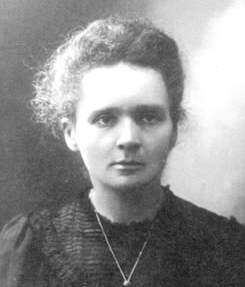Marie Curie
Maria Sklodowska-Curie (November 7, 1867- July 4, 1934) was a pioneer in the early field of radiation and a Nobel laureate.
Born in Warsaw, Poland, she moved to Paris and studied chemistry and physics at the Sorbonne, where she became the first woman to teach there. At the Sorbonne she met another instructor, Pierre Curie and married him; together they studied radioactive materials, particularly the uranium ore pitchblende, which had the curious property of being more radioactive than the uranium extracted from it. The logical explanation of this was that the pitchblende contained traces of some unknown radioactive component that was far more radioactive than uranium. Over several years of unceasing labour they refined several tons of pitchblende, progressively concentrating the radioactive components, and eventually isolated two new chemical elements. The first they named polonium after Marie's native country, and the other was named radium from its intense radioactivity.
Together with Pierre Curie and Henri Becquerel, she was awarded the Nobel Prize in Physics, 1903: "in recognition of the extraordinary services they have rendered by their joint researches on the radiation phenomena discovered by Professor Henri Becquerel". She was the first woman to be awarded a Nobel Prize.
Eight years later, she received the Nobel Prize in Chemistry, 1911 "in recognition of her services to the advancement of chemistry by the discovery of the elements radium and polonium, by the isolation of radium and the study of the nature and compounds of this remarkable element". In an unusual move, Curie intentionally did not patent the radium isolation process, instead leaving it open so the scientific community could research unhindered.
She was the first person to win or share two Nobel Prizes. She is one of only two people who has been awarded a Nobel Prize in two different fields, the other being Linus Pauling.
After her husband's death, she had an affair with physicist Paul Langevin, a married man, which resulted in a press scandal, sometimes reeking of xenophobia.
During World War I, she pushed for the use of mobile radiography units for the treatment of wounded soldiers. In 1921, she did a tour of the United States, where she was welcomed triumphantly, to raise funds for research on radium.
In her later years, she was disappointed by the myriad of physicians and makers of cosmetics who used radioactive material without precautions.
Her death near Sallanches, France in 1934 was from leukemia, almost certainly due to her massive exposure to radiation in her work.
Her eldest daughter, Irène Joliot-Curie, won a Nobel Prize for Chemistry in 1935, the year after Marie Curie's death.
In 1995, Madame Curie was the first woman laid to rest under the famous dome of The Panthéon in Paris on her own merits.
During a period of hyperinflation in the 1990s, she was on the Polish 20,000-zloty banknote.
There is a biographical film about her. An extremely ahistorical Marie Curie appears as a character in the comedy Young Einstein by Yahoo Serious.
Bibliography
- Madame Curie: A Biography, by Eve Curie, ISBN 0306810387
- Marie Curie: A Life, by Susan Quinn, ISBN 0201887940
External link

